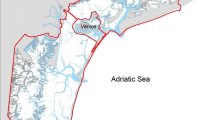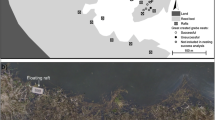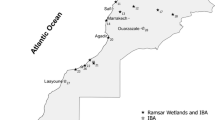Abstract
We explored whether the recent large-scale population decline of Eurasian wigeon (Anas penelope) in Europe may be linked to long-term vegetation changes in their boreal breeding wetlands. First, we assessed the importance of Equisetum, Phragmites, and Carex stands in lake selection by pairs and in foraging habitat selection by broods. Second, in 2013–2014 we revisited 58 lakes in Sweden and Finland studied in 1990–1991, to examine if there had been any long-term change in the abundance of habitat types preferred by wigeon. Finally, using continuous long-term data on breeding numbers of wigeon in 18 of the lakes studied in 1990–1991, we examined if wigeon numbers had changed at lakes where the habitat also had changed. We found that lake occupation of nesting wigeon pairs and foraging habitat use of broods were associated with the extent of Equisetum stands. The presence and abundance of this preferred habitat declined dramatically from 1990–1991 to 2013–2014 in the lakes from which the presence–absence data of wigeon emanate. Breeding numbers of wigeon showed a long-term declining trend in lakes where Equisetum has decreased. Our results imply that the recent population decline of wigeon in Europe may be linked to decrease of Equisetum habitat.



Similar content being viewed by others
References
Bakker, E. S., J. F. Pagès, R. Arthur & T. Alcoverro, 2016a. Assessing the role of large herbivores in the structuring and functioning of freshwater and marine angiosperm ecosystems. Ecography 39: 162–179.
Bakker, E. S., K. A. Wood, J. F. Pagès, G. F. Veend, M. J. A. Christianen, L. Santamaría, B. A. Nolet & S. Hilt, 2016b. Herbivory on freshwater and marine macrophytes: a review and perspective. Aquatic Botany. doi:10.1016/j.aquabot.2016.04.008.
Bender, D. J., D. A. Contreras & L. Fahrig, 1998. Habitat loss and population decline: a meta-analysis of the patch size effect. Ecology 79: 517–533.
Bennett, A. F. & D. A. Saunders, 2010. Habitat fragmentation and landscape change. In Sodhi, N. S. & P. R. Ehrlich (eds), Conservation Biology for All. Oxford University Press, Oxford: 88–106.
Bethke, R. W. & T. D. Nudds, 1995. Effects of climate change and land use on duck abundance in Canadian prairie-parklands. Ecological Applications 5: 588–600.
Burnham, K. P. & D. R. Anderson, 2002. Model Selection and Multimodel Inference: A Practical Information-theoretic Approach, 2nd ed. Springer, New York.
Burnham, K. P., D. R. Anderson & K. P. Huyvaert, 2011. AIC model selection and multimodel inference in behavioral ecology: some background, observations, and comparisons. Behavioral Ecology and Sociobiology 65: 23–35.
Christensen, T. K. & A. D. Fox, 2014. Changes in age and sex ratios amongst samples of hunter-shot wings from common duck species in Denmark 1982-2010. European Journal of Wildlife Research 60: 303–312.
Danell, K., 1977. Short-term plant successions following the colonization of a northern Swedish lake by the muskrat, Ondatra zibethica. Journal of Applied Ecology 14: 933–947.
Danell, K., 1979. Reduction of aquatic vegetation following the colonization of a northern Swedish lake by the muskrat, Ondatra zibethica. Oecologia 38: 101–106.
Danell, K., 1996. Introductions of aquatic rodents: lessons of the muskrat Ondatra zibethicus invasion. Wildlife Biology 2: 213–220.
Elmberg, J., P. Nummi, H. Pöysä & K. Sjöberg, 1993. Factors affecting species number and density of dabbling duck guilds in North Europe. Ecography 16: 251–260.
Finnish Invasive Alien Species Portal, 2016. http://www.vieraslajit.fi/fi/lajit/MX.40510/show. Accessed 16 June 2016.
Fischer, J. & D. B. Lindenmayer, 2007. Landscape modification and habitat fragmentation: a synthesis. Global Ecology and Biogeography 16: 265–280.
Fox, A. D., J. E. Jónsson, T. Aarvak, T. Bregnballe, T. K. Christensen, K. K. Clausen, P. Clausen, L. Dalby, T. E. Holm, D. Pavón-Jordan, K. Laursen, A. Lehikoinen, S.-H. Lorentsen, A. P. Møller, M. Nordström, M. Öst, P. Söderquist & O. R. Therkildsen, 2015. Current and potential threats to Nordic duck populations – a horizon scanning exercise. Annales Zoologici Fennici 52: 193–220.
Fox, A. D., L. Dalby, T. K. Christensen, S. Nagy, T. J. S. Balsby, O. Crowe, P. Clausen, B. Deceuninck, K. Devos, C. A. Holt, M. Hornman, V. Keller, T. Langendoen, A. Lehikoinen, S.-H. Lorentsen, B. Molina, L. Nilsson, A. Stipniece, J.-C. Svenning & J. Wahl, 2016. Seeking explanations for recent changes in abundance of wintering Eurasian Wigeon (Anas penelope) in northwest Europe. Ornis Fennica 93: 12–25.
Fretwell, S. D. & H. L. Lucas Jr., 1970. On territorial behavior and other factors influencing habitat distribution in birds. I. Theoretical development. Acta Biotheoretica 19: 16–36.
Gayet, G., M. Guillemain, P. Defos du Rau & P. Grillas, 2014. Effects of mute swans on wetlands: a synthesis. Hydrobiologia 723: 195–204.
Guillemain, M., A. D. Fox, H. Pöysä, V.-M. Väänänen, T. K. Christensen, P. Triplet, V. Schricke & F. Korner-Nievergelt, 2013a. Autumn survival inferred from wing age ratios: Wigeon juvenile survival half that of adults at best? Journal of Ornithology 154: 351–358.
Guillemain, M., H. Pöysä, A. D. Fox, C. Arzel, L. Dessborn, J. Ekroos, G. Gunnarsson, T. E. Holm, T. K. Christensen, A. Lehikoinen, C. Mitchell, J. Rintala & A. P. Møller, 2013b. Effects of climate change on European ducks: what do we know and what do we need to know? Wildlife Biology 19: 404–419.
Haapanen, A., M. Helminen & H. K. Suomalainen, 1977. The summer behaviour and habitat use of the whooper swan, Cygnus c. cygnus. Finnish Game Research 36: 49–81.
Holopainen, S., C. Arzel, L. Dessborn, J. Elmberg, G. Gunnarsson, P. Nummi, H. Pöysä & K. Sjöberg, 2015. Habitat use in ducks breeding in boreal freshwater wetlands: a review. European Journal of Wildlife Research 61: 339–363.
Jacobsen, O. W., 1991. Feeding behavior of breeding wigeon Anas penelope in relation to seasonal emergence and swarming behavior of chironomids. Ardea 79: 309–418.
Jacobsen, O. W., 1993. Use of feeding habitats by breeding Eurasian wigeon. Canadian Journal of Zoology 71: 1046–1054.
Knudsen, H. L., B. Laubek & A. Ohtonen, 2002. Growth and survival of whooper swan cygnets reared in different habitats in Finland. Waterbirds 25: 211–220.
Koskimies, P. & R. A. Väisänen, 1991. Monitoring Bird Populations. A Manual of Methods Applied in Finland. Zoological Museum, University of Helsinki, Helsinki.
Kritzberg, E. S. & S. M. Ekström, 2012. Increasing iron concentrations in surface waters – a factor behind brownification? Biogeosciences 9: 1465–1478.
Lampinen, R. & T. Lahti, 2011. Kasviatlas 2010. Helsingin Yliopisto, Luonnontieteellinen keskusmuseo (Finnish Museum of Natural History Luomus), Kasvimuseo, Helsinki. http://www.luomus.fi/kasviatlas.
Lehikoinen, A., J. Rintala, E. Lammi & H. Pöysä, 2016. Habitat-specific population trajectories in boreal waterbirds: alarming trends and bioindicators for wetlands. Animal Conservation 19: 88–95.
Mantyka-Pringle, C. S., T. G. Martin & J. R. Rhodes, 2012. Interactions between climate and habitat loss effects on biodiversity: a systematic review and meta-analysis. Global Change Biology 18: 1239–1252.
MacCracken, J. G., V. van Ballenberghe & J. M. Peek, 1997. Habitat relationships of moose on the Copper River Delta in coastal south-central Alaska. Wildlife Monographs 136: 3–52.
Mitchell, C., A. D. Fox, J. Harradine & I. Clausager, 2008. Measures of annual reproductive success amongst Eurasian wigeon Anas penelope. Bird Study 55: 43–51.
Monteith, D. T., J. L. Stoddard, C. D. Evans, H. A. de Wit, M. Forsius, T. Høgåsen, A. Wilander, B. L. Skjelkvåle, D. S. Jeffries, J. Vuorenmaa, B. Keller, J. Kopacek & J. Vesely, 2007. Dissolved organic carbon trends resulting from changes in atmospheric deposition chemistry. Nature 450: 537–541.
Nummi, P. & H. Pöysä, 1993. Habitat associations of ducks during different phases of the breeding season. Ecography 16: 319–328.
Nummi, P. & H. Pöysä, 1995. Habitat use by different-aged duck broods and juvenile ducks. Wildlife Biology 1: 181–187.
Nummi, P., V.-M. Väänänen & J. Malinen, 2006. Alien grazing: indirect effects of muskrats on invertebrates. Biological Invasions 8: 993–999.
Nummi, P., A. Paasivaara, S. Suhonen & H. Pöysä, 2013. Wetland use by brood-rearing female ducks in a boreal forest landscape: the importance of food and habitat. Ibis 155: 68–79.
Nummi, P., S. Holopainen, J. Rintala & H. Pöysä, 2015. Mechanisms of density dependence in ducks: importance of space and per capita food. Oecologia 177: 679–688.
Ojala, A., P. Kankaala & T. Tulonen, 2002. Growth response of Equisetum fluviatile to elevated CO2 and temperature. Environmental and Experimental Botany 47: 157–171.
Ottosson, U., R. Ottvall, J. Elmberg, M. Green, R. Gustafsson, F. Haas, N. Holmqvist, Å. Lindström, L. Nilsson, M. Svensson & M. Tjernberg, 2012. Fåglarna i Sverige – antal och förekomst. Sveriges Ornitologiska Förening, Stockholm (in Swedish with English summary).
Pirkola, M. K. & J. Högmander, 1974. Sorsapoikueiden iänmääritys. Suomen Riista 25: 50–55. (in Finnish with English summary).
Porzig, E. L., N. E. Seavy, T. Gardali, G. R. Geupel, M. Holyoak & J. M. Eadie, 2014. Habitat suitability through time: using time series and habitat models to understand changes in bird density. Ecosphere 5(2): 12.
Pöysä, H. & M. Pesonen, 2003. Density dependence, regulation and open-closed populations: insights from the wigeon, Anas penelope. Oikos 102: 358–366.
Pöysä, H. & J. Sorjonen, 2000. Recolonization of breeding waterfowl communities by the whooper swan: vacant niches available. Ecography 23: 342–348.
Pöysä, H., J. Rintala, A. Lehikoinen & R. A. Väisänen, 2013. The importance of hunting pressure, habitat preference and life history for population trends of breeding waterbirds in Finland. European Journal of Wildlife Research 59: 245–256.
Roach, J. K. & N. Griffith, 2015. Climate-induced lake drying causes heterogeneous reductions in waterfowl species richness. Landscape Ecology 30: 1005–1022.
Selwood, K. E., M. A. McGeoch & R. Mac Nally, 2015. The effects of climate change and land-use change on demographic rates and population viability. Biological Reviews 90: 837–853.
Smirnov, V. V. & K. Tretyakov, 1998. Changes in aquatic plant communities on the island of Valaam due to invarion by the muskrat Ondatra zibethicus L. (Rodentia, Mammalia). Biodiversity and Conservation 7: 673–690.
Suhonen, S., P. Nummi & H. Pöysä, 2011. Long term stability of habitats and their use by ducks in boreal lakes. Boreal Environmental Research 16(suppl. B): 71–80.
Sulkava, R., 2008. Joutsenet kortteikon harventajina. Suomenselän Linnut 43: 104–105. (in Finnish).
Toivonen, H. & P. Huttunen, 1995. Aquatic macrophytes and ecological gradients in 57 small lakes in southern Finland. Aquatic Botany 51: 197–221.
Toivonen, H. & J. Meriläinen, 1980. Impact of the muskrat (Ondatra zibethica L.) on aquatic vegetation in small Finnish lakes. Developments in Hydrobiology 3: 131–138.
Travis, J. M., 2003. Climate change and habitat destruction: a deadly anthropogenic cocktail. Proceedings of the Royal Society of London B 270: 467–473.
Valkama, J., V. Vepsäläinen & A. Lehikoinen, 2011. The Third Finnish Breeding Bird Atlas. Finnish Museum of Natural History and Ministry of Environment. http://atlas3.lintuatlas.fi/english. Accessed 29 Jan, 2016
Vuorinen, E. & A. Janatuinen, 2014. Hiidenveden kasvillisuus- ja petokalaselvitys. Silvetris Oy, Karjaa, 75 pp (in Finnish).
Weyhenmeyer, G. A., Y. T. Prairie & L. J. Tranvik, 2014. Browning of boreal freshwaters coupled to carbon-iron interactions along the aquatic continuum. PloS One 9(2): e88104.
Wood, K. A., R. A. Stillman, R. T. Clarke, F. Daunt & M. T. O’Hare, 2012. The impact of waterfowl herbivory on plant standing crop: a meta-analysis. Hydrobiologia 686: 157–167.
Wood, K. A., M. T. O’Hare, C. McDonald, K. R. Searle, F. Daunt & R. T. Stillman, 2016. Herbivore regulation of plant abundance in aquatic ecosystems. Biological Reviews. doi:10.1111/brv.12272.
Acknowledgments
The study was supported by Grants from the Foundation for Research of Natural Resources in Finland, by the Swedish Environmental Protection Board, and by the Nordic Council for Wildlife Research. The authors thank a large number of people who have contributed to the fieldwork. Comments by two anonymous reviewers improved the manuscript.
Author information
Authors and Affiliations
Corresponding author
Additional information
Handling editor: Stuart Anthony Halse
Rights and permissions
About this article
Cite this article
Pöysä, H., Elmberg, J., Gunnarsson, G. et al. Habitat associations and habitat change: seeking explanation for population decline in breeding Eurasian wigeon Anas penelope . Hydrobiologia 785, 207–217 (2017). https://doi.org/10.1007/s10750-016-2922-4
Received:
Revised:
Accepted:
Published:
Issue Date:
DOI: https://doi.org/10.1007/s10750-016-2922-4




